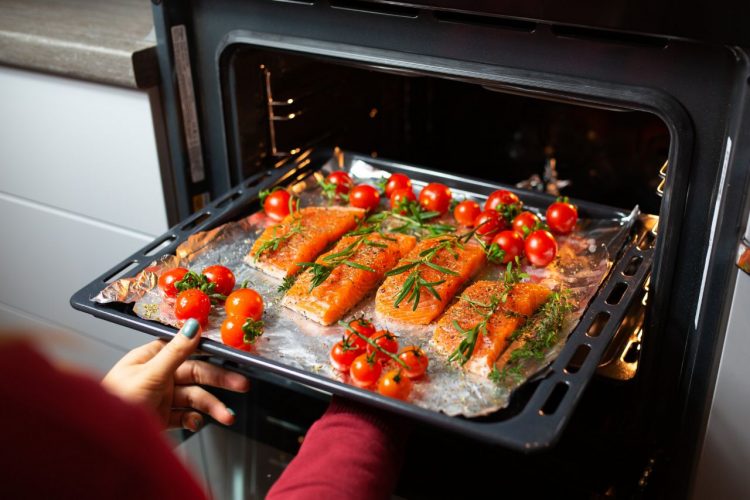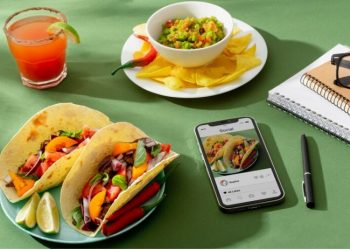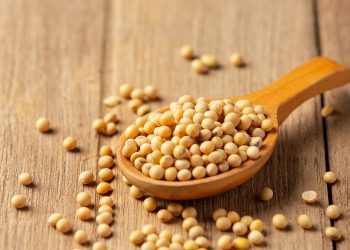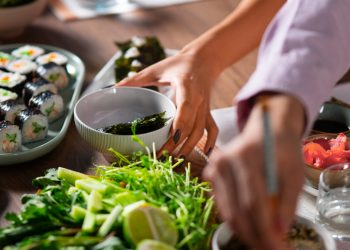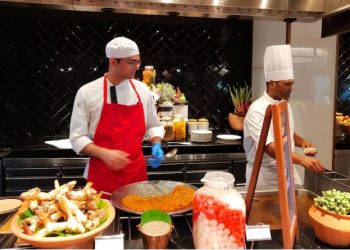When it comes to cooking salmon, achieving the perfect balance of texture and flavor is crucial. We will explore how long to cook salmon at 400 °F in both the oven and the air fryer.
Baking Salmon in Oven at 400 F (200°C)
To start, let’s try baking salmon in oven at 400°F (200°C). The cooking time depends on several factors and may vary slightly. It’s essential to understand these variables to determine the ideal cooking time for your specific cut of salmon.
Based on my experiences in baking fish like tuna or pangasius fish, the thickness of the cut plays a significant role in determining cooking time. A 1/2-inch cut will cook faster than a 2-inch cut, even if they have the same weight. For the most popular salmon fillet cut size of 1 – 1.5 inches, the recommended time to bake it at 400°F (200°C) in the oven is 10 – 15 minutes, respectively.
How about medium-rare salmon? Consuming salmon that is cooked to a raw, rare or medium-rare state carries certain risks. Indeed, it’s important to note that consuming raw or undercooked fish, especially wild salmon, carries a higher risk of foodborne illnesses, so it’s essential to source your salmon from reputable suppliers and ensure its freshness.Therefore, ensure you get safe and healthy fish first.
To result in medium-rare salmon, cut off the baking time to 6 minutes for 1-inch cut and 8 minutes for 1.5-inches one.
With frozen salmon, definitely it takes more time to bring it to be fully cooked. Preheat your oven to 425°F (220°C). Bake for approximately 12-15 minutes per inch of thickness. Also let it rest for a few minutes before serving.
For a whole salmon, you have to estimate the cooking time based on its weight. As a general guideline, you should bake the fish for approximately 15-20 minutes per pound. For instance, 2-pound salmon will require around 30-40 minutes in the oven.
Cooking Salmon at 400 °F (200°C) in the Air Fryer
Now, let’s shift our focus to cooking salmon at 400 °F in an air fryer. The air fryer provides a quick and efficient method for preparing this delectable fish. At a constant temperature of 400°F, similar to many others dishes such as meatballs or chicken, the cooking time for air fryer is shorter, thanks to the hot air circulation mechanism.
For a 1-inch cut, which typically weighs between 5 to 7 ounces, you can expect the salmon to cook in approximately 7 minutes. For 1.5 inches cut, let it cook in 10 minutes.
Internal temperature of fully cooked salmon
To determine if your salmon fillet has been fully cooked, the internal temperature is the most accurate method of assessment. For “well-done” salmon, the internal temperature (at the thickest part) of the fillet should reach around 145°F (63°C). This higher temperature ensures that the fish is thoroughly cooked, resulting in a firm and opaque texture throughout the fillet. At this stage, the salmon is cooked all the way through, and its juices run clear.
On the other hands, medium-rare salmon is cooked to an internal temperature of approximately 125°F (52°C). This temperature allows the center of the fish to remain slightly translucent and moist, with a delicate flakiness. It strikes a balance between fully cooked and raw, providing a delightful dining experience.
For those who appreciate the delicate flavors of rare salmon, the internal temperature should be about 115°F (46°C). Rare salmon is cooked just enough to develop a light crust on the outside while leaving the center of the fish mostly raw and cool to the touch. This style of cooking preserves the natural tenderness and delicate texture of the fish, delivering a unique culinary experience.
Aside from using a thermometer to check the temperature, there are also other ways to gauge the doneness of salmon. My method is to observe the texture and color of the fish. A fully cooked salmon should be firm but still moist, and the color should change from translucent to opaque. Additionally, you can use the touch test: gently press the salmon with your finger, and if it feels firm and springs back slightly, it is likely cooked to medium-rare.
However, these methods might require some experience and practice to master, so using a food thermometer is generally the most reliable way to ensure accurate results and guarantee food safety.
Tips for Perfect Baked Salmon
Achieving a perfect baked salmon needs a few helpful tips. Firstly, prioritize selecting the freshest cut of salmon. Look for vibrant colors and firm flesh. Then, don’t be afraid to experiment with different seasonings and marinades to enhance the flavor of your salmon. Also, don’t forget to preheat the oven/air fryer before baking.
Understanding the cooking time with the temperature of 400°F (200°C) is crucial for achieving the desired results. Whether using the oven or air fryer, the thickness of the cut and desired doneness are key factors to consider. By following the recommended guidelines and incorporating these tips, you’ll be well on your way to creating delectable baked salmon dishes. So, get ready to savor the delightful flavors and textures of this remarkable fish.
What to Do with Leftover Cooked Salmon?
When you have to face with leftover cooked salmon, don’t worry, there are numerous salmon recipes to transform it into a delicious new dish.
- Salmon salad: Let’s flake the salmon and use it as a topping for a salad. Combine it with fresh greens, cherry tomatoes, avocado slices, and a tangy dressing for a refreshing and nutritious meal.
- Salmon cakes or patties: Mix the flaked salmon with breadcrumbs, chopped herbs, eggs, and seasonings, then shape the mixture into patties and pan-fry them until golden brown. Serve them with a side of tartar sauce or a zesty lemon aioli for a delightful seafood treat.
- Salmon pasta: Toss the flaked salmon with al dente pasta, sautéed garlic, and your favorite vegetables, then finish with a drizzle of olive oil and a sprinkle of grated Parmesan cheese.
- Salmon and cream cheese spread: Mix the flaked salmon with cream cheese, lemon juice, dill, and a touch of salt and pepper, then spread it onto bagels or crackers for a quick and satisfying snack.
- Salmon Fried Rice: Sauté the flaked salmon with cooked rice, mixed vegetables, and soy sauce. Add some scrambled eggs for extra protein and flavor. It’s a quick and satisfying way to transform your leftovers.
- Salmon Croquettes: Mix the flaked salmon with breadcrumbs, beaten eggs, chopped herbs, and seasonings. Shape the mixture into patties and pan-fry them until golden brown. Enjoy them as a main dish or in sandwiches.
Reheat Cooked Salmon
However, what if you haven’t found any favorite idea with the leftover? Just preserve it in fridge for next time! To store leftover cooked salmon properly, it’s essential to refrigerate it promptly. Place the salmon in an airtight container or wrap it tightly in plastic wrap to prevent air exposure, which can cause it to spoil faster. Store it in the coldest part of your refrigerator and consume it within 2-3 days for optimal freshness.
When it’s time to reheat the leftover salmon, it’s best to use gentle methods to preserve its delicate texture. One option is to wrap the salmon in aluminum foil and place it in a preheated oven at a low temperature, around 275°F (135°C), until heated through. You can also reheat it in a non-stick skillet over low heat, adding a splash of water or broth to prevent it from drying out. Another quick option is to use a microwave on a low power setting, checking frequently to ensure it doesn’t overcook.
Remember to only reheat the salmon once to avoid any potential food safety risks. Once reheated, enjoy the salmon in various ways, such as serving it with steamed vegetables, alongside a bed of fluffy rice, or on top of a salad for a delightful meal.

